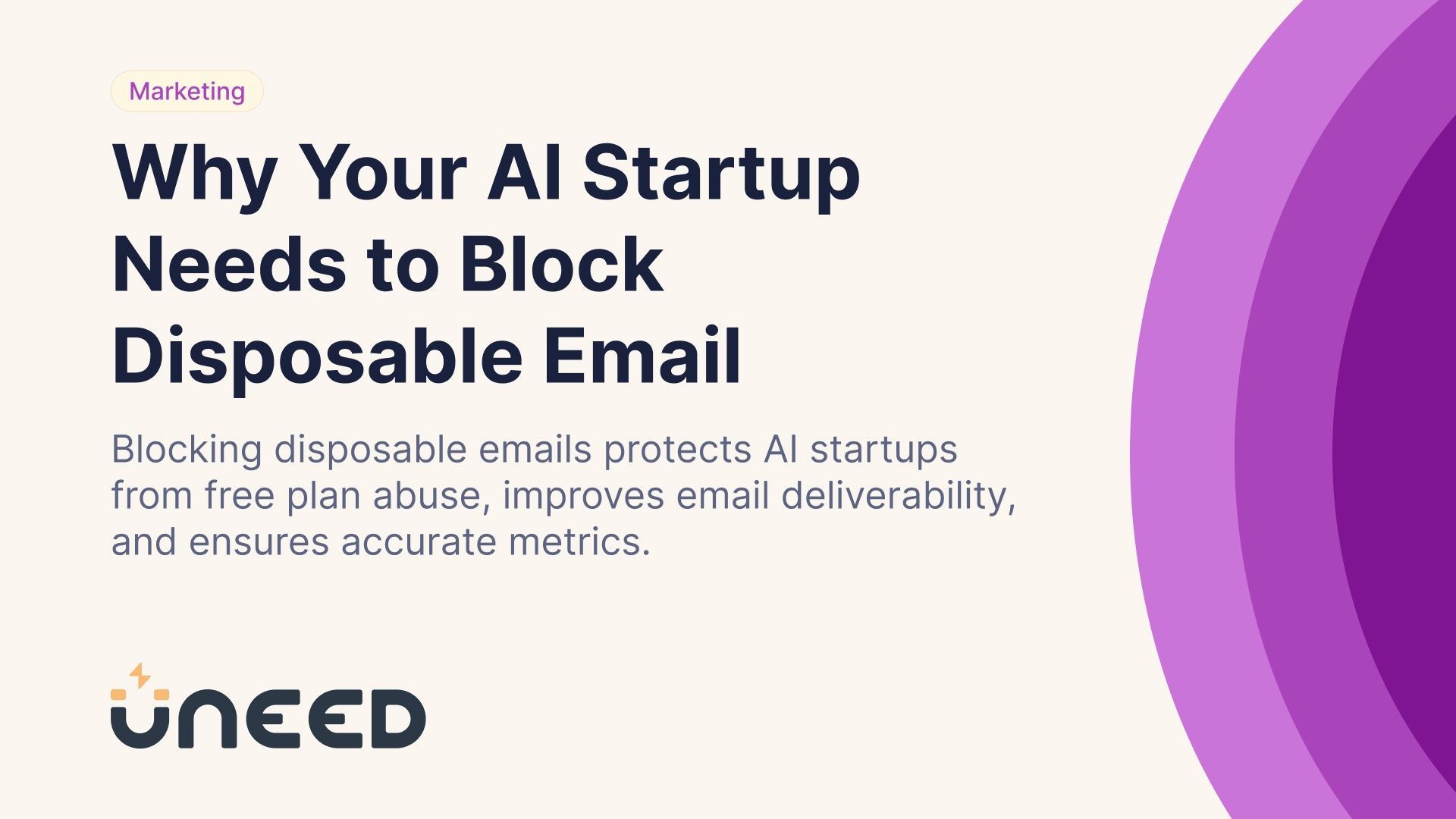
Why Your AI Startup Needs to Block Disposable Email
Blocking disposable emails protects AI startups from free plan abuse, improves email deliverability, and ensures accurate metrics.
TL;DR
- Blocking disposable emails will save your AI startups and SaaS platforms from free plan and free trial abuse, will improve your email deliverability, and give you more reliable user metrics.
- Identifying and preventing signups from disposable email providers is hard because they use new domains every day.
- Many companies use static block lists, but the most reliable way is using an API because it is always up to date.
- The API from IsTempMail is an effective solution to block disposable email
What are disposable or temporary email addresses?
Disposable emails are email addresses that users create and use for short periods of time. The intentions range from avoiding spam and maintaining privacy to flat out trying to cheat. Many services exist that make creating these throwaway addresses really convenient. They pose a challenge for many businesses, especially for AI startups and SaaS platforms. In this post, we’ll look at the major problem your company can face from disposable emails. And we’ll talk about why blocking fake users is essential for your business.
Problem 1: Free Plan Abuse
One of the primary issues with disposable emails is the abuse of free plans. Individuals can create and use multiple accounts simultaneously. Using temporary addresses, they are taking unfair advantage of the free resources you offer. This can drain your resources, especially for AI startups where you have costs that typically scale almost linearly with usage. You may see increased operational costs and/or reduced service quality.
Blocking disposable emails helps mitigate these problems by ensuring that only users with valid, long-term email addresses can access your free plans. This way, your resources are used as intended, providing value to genuine users and maintaining the integrity of your service offerings.
Problem 2: Free Trial Abuse
Free trial abuse is pretty similar to free plan abuse. Using throwaway emails users can repeatedly sign up for free trials, accessing your premium features forever – without paying. This will hurt your trial-to-paid conversion rate and overall revenue as well as increase your costs. Again this is true especially for AI companies that pay usage-based fees to their service providers.
You can make sure trials are mostly used by legitimate potential customers by blocking signups from disposable email domains.
Problem 3: Email Deliverability
Allowing disposable emails can negatively impact your email deliverability rates. Emails sent to temporary email addresses are more likely to bounce. This can and will damage your email sender reputation. It is therefore highly recommended to block temporary email for all signups, no matter whether it’s for your product, a newsletter, or other marketing channels.
Decreased deliverability affects both transactional emails and marketing campaigns. Any email going to spam instead of inboxes makes communication with your audience and users less reliable.
Emails like signup confirmations or password resets in spam, will hurt your user acquisition and increase contact rates. If marketing campaigns do not reach their recipients your marketing won’t be as effective and give you inferior results (open rates, conversions).
Problem 4: Skewed User Metrics
As discussed above, inflated trial user numbers can lead to misleading metrics, the same is true for inflated free plan user numbers. It will be difficult to gauge the actual demand for your app or a certain service.
When analyzing user behavior, you will base your decisions on skewed data. This can result in missed opportunities and misguided efforts. You might overestimate the number of active users, or underestimate churn. Blocking throwaway emails gives you more reliable user activity data.
Solution: Disposable Email Blocklist API
There are basically two options that are manageable in terms of effort. Maintaining your own list of domains is not one of them. Disposable email providers use new domain names every day, and new providers pop up every day. Don’t try to make your own list. It’ll be outdated the moment you stop editing it.
Blocklist API
The most reliable way to block disposable email is using an API. A popular option is IsTempMail, though others exist, too.
The advantage of an API is that you do not have any maintenance work. You'll always be using the latest data, as the list of blocked email domains is updated constantly in the background. Pricing is really reasonable with IsTempMail also offering a free plan for 200 checks a month.
Static Blocklists
The second-best option is static blocklists, many are available on GitHub and in other places. The most well known is disposable/disposable.
These lists are updated regularly too. The drawback is that you'll have to implement a mechanism to update them in your app. Disposable domains and providers emerge literally every day. So you’ll ideally update your list and deploy daily.
Takeaway
Blocking disposable emails can address many issues with user management you may have at your AI startup or SaaS product. It will combat free plan abuse and free trial abuse, improve email deliverability, and provide you with more accurate user metrics. This allows you to provide a better service for your users – at lower cost.
You can get started easily by using an API to block disposable email in your signup flow. IsTempMail is a great choice with reasonable pricing and a free plan for when you are just starting out.
Micro SaaS HQ Review
We've tested Micro Saas HQ, the exclusive community for Micro SaaS founders
Bento Review - Better than Convertkit in 2025?
We've tested Bento, Email & Automation for FAST Growing Startups